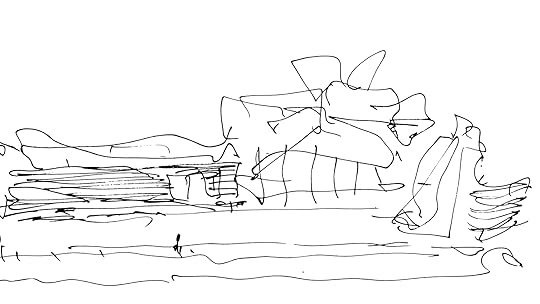Here’s an architectural drawing by Frank Lloyd Wright:

And here’s one by Frank Gehry:

Now, Gehry’s sketches are quite interesting, I think. My point is not that they’re worse than Wright’s, but that they are radically different and serve a different purpose. Gehry wasn’t going to spend a lot of time working out the details of a building — its structure or its appearance — because that’s what CAD (Computer Assisted Design) software is for. Before CAD came around, Gehry drew like this:

He would’ve had to learn to draw that way when at school. I wonder how much of that skill he retained … or maybe I should say, how long he retained it?
Architects have been debating the importance of drawing for several decades now. There was a bit of a kerfuffle in the business a decade ago when an architecture student said that he had been taught to draw, and acknowledged that “most people” he had asked thought it valuable, but did not seem to think that the skill had any real use. Indeed, he felt that drawing was a time-consuming distraction from what he thought his real job: “generating concepts.”
Me, I’m more interested in those who make art than those who generate concepts. But to each his own.
And I’m not just interested in works of art, I’m interested — passionately interested — in works of art that lead to other works of art. I love architectural drawings like Wright’s. I love the magnificent cartoons by Leonardo and Raphael. I prefer Constable’s sketches to his oil paintings.
And maybe above all I love musical demos.
The Beatles’ Esher demos mean more to me than the White Album. The gorgeous productions of Joni Mitchell’s Asylum albums just might be transcended, but in any case are put in their proper context, by her voice-and-guitar demos — and just listen to “Coyote” when she was still working it out. The best music Paul McCartney did in his post-Beatles career was his brief partnership with Elvis Costello, and their demo of “My Brave Face” is magnificent — far better than the more polished version that was eventually released. Bob Dylan’s “Mississippi” (from Love and Theft) is a fine song, but the earlier, simpler, demo-like version is truly great.
What I’m loving here — of course! — is human effort, human exploration, figuring it out, trial and error, rough edges, things in progress: the rough ground. I’m basically repeating here the message of Nick Carr’s book The Glass Cage, and much of Matt Crawford’s work, and more than a few of my earlier essays, but: automation deskills. Art that hasn’t been taken through the long slow process of developmental demonstration — art that has shied from resistance and pursued “the smooth things” — will suffer, will settle for the predictable and palatable, will be boring. And the exercise of hard-won human skills is a good thing in itself, regardless of what “product” it leads to. But you all know that. Demos and sketches and architectural drawings are cool, is what I’m saying.
 newest »
newest »
 newest »
newest »
 Artists "generating concepts" is how we get duct-taped bananas and piss Christ's, or the emperor has no sculpture, a concept that has been used more than once. So much of modern art smacks more of laziness than anything else, and not only on the part of the artists, but also on the part of the reviewers, and the museums.
Artists "generating concepts" is how we get duct-taped bananas and piss Christ's, or the emperor has no sculpture, a concept that has been used more than once. So much of modern art smacks more of laziness than anything else, and not only on the part of the artists, but also on the part of the reviewers, and the museums.






